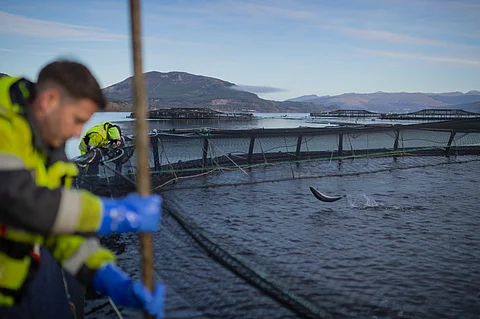

Salmon farmers while looking after the health and welfare of the fish in Scotland.
Photo: Nick Mailer / Salmon Scotland.
Survival rates for farmed salmon in Scotland have reached record levels in the first half of 2025. According to Salmon Scotland, new figures showed that monthly survival averaged 99.12% between January and June, the best start to the year since the data began to be published voluntarily in 2018.
The trade body, which earlier this year acknowledged that all food producers experience challenges beyond their control while denouncing what it considered a double standard used when comparing salmon farming to other forms of animal protein production, has now pointed out that these figures reflect continuing improvements in fish health and environmental conditions in the Scottish salmon industry.
"These figures demonstrate our members' commitment to fish health and welfare, and to responsible farming," Tavish Scott, CEO of Salmon Scotland, stated. "Scottish salmon farmers uphold the highest animal welfare standards in the world, but they are always striving to do better."
"The hard work of our farmers, supported by more than a billion pounds of investment in new technology, has been rewarded with survival rates at record highs," he added.
Salmon Scotland also highlighted that the Scottish salmon industry is the only one in the UK to publish survival statistics, and that, as noted by its CEO, the sector has invested over GBP 1 billion in innovation in areas such as veterinary care, technology, and stock management since 2018.
The measures, which include state-of-the-art freshwater treatment vessels, research, efforts to reduce the time salmon spend at sea, staff training, and improved monitoring systems, are helping fish farmers better manage jellyfish blooms and warmer seawater, improving both fish health and sustainability.
Thus, the trade body claimed that this solid start to 2025 builds on last year's progress, when cumulative mortality, i.e., the total number of fish deaths over time, was reduced by more than a third. In 2024, overall survival across all farms reached 82.3%, up 10 percentage points from 72.3% the previous year.
A higher survival rate, Salmon Scotland pointed out, means more protein-rich foods with a low carbon footprint reach consumers, bolstering food security and driving economic growth through increased sales both domestically and internationally.
Last year, Scottish salmon exports increased by 45% to GBP 844 million, equivalent to GBP 2.31 million per day, which not only set a record but cemented Scottish salmon as the UK's largest food export.
But demand for Scottish salmon is not only increasing overseas, it is also increasing within the country. In the 12 months to June 2024, domestic sales of Scotland-sourced salmon also grew. They did so by 9.1% keeping salmon as the UK's most popular fish.
"This is thanks to its reputation for quality and sustainability, and the vital role it plays in supporting coastal communities and the wider economy," Tavish Scott said.
"Consumers continue to clamour for Scottish salmon. They recognise the quality and nutritional value of the fish we grow in our seas," the CEO of Salmon Scotland concluded.
